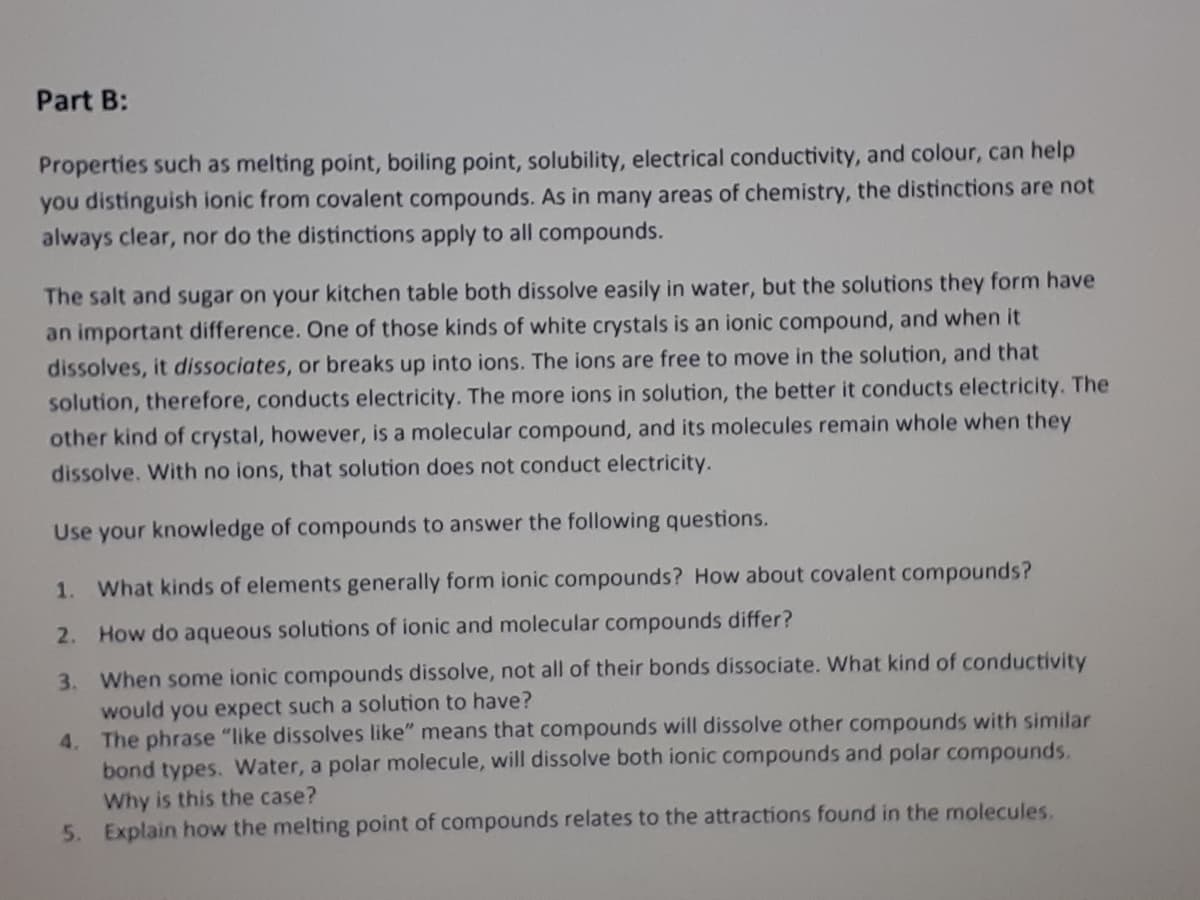Principles of Modern Chemistry
8th Edition
ISBN:9781305079113
Author:David W. Oxtoby, H. Pat Gillis, Laurie J. Butler
Publisher:David W. Oxtoby, H. Pat Gillis, Laurie J. Butler
Chapter3: Atomic Shells And Classical Models Of Chemical Bonding
Section: Chapter Questions
Problem 86AP
Related questions
Question
Please just answer question 5

Transcribed Image Text:Part B:
Properties such as melting point, boiling point, solubility, electrical conductivity, and colour, can help
you distinguish ionic from covalent compounds. As in many areas of chemistry, the distinctions are not
always clear, nor do the distinctions apply to all compounds.
The salt and sugar on your kitchen table both dissolve easily in water, but the solutions they form have
an important difference. One of those kinds of white crystals is an ionic compound, and when it
dissolves, it dissociates, or breaks up into ions. The ions are free to move in the solution, and that
solution, therefore, conducts electricity. The more ions in solution, the better it conducts electricity. The
other kind of crystal, however, is a molecular compound, and its molecules remain whole when they
dissolve. With no ions, that solution does not conduct electricity.
Use your knowledge of compounds to answer the following questions.
1. What kinds of elements generally form ionic compounds? How about covalent compounds?
2. How do aqueous solutions of ionic and molecular compounds differ?
3. When some ionic compounds dissolve, not all of their bonds dissociate. What kind of conductivity
would you expect such a solution to have?
4. The phrase "like dissolves like" means that compounds will dissolve other compounds with similar
bond types. Water, a polar molecule, will dissolve both ionic compounds and polar compounds.
Why is this the case?
5. Explain how the melting point of compounds relates to the attractions found in the molecules.
Expert Solution
This question has been solved!
Explore an expertly crafted, step-by-step solution for a thorough understanding of key concepts.
Step by step
Solved in 2 steps

Knowledge Booster
Learn more about
Need a deep-dive on the concept behind this application? Look no further. Learn more about this topic, chemistry and related others by exploring similar questions and additional content below.Recommended textbooks for you

Principles of Modern Chemistry
Chemistry
ISBN:
9781305079113
Author:
David W. Oxtoby, H. Pat Gillis, Laurie J. Butler
Publisher:
Cengage Learning

General, Organic, and Biological Chemistry
Chemistry
ISBN:
9781285853918
Author:
H. Stephen Stoker
Publisher:
Cengage Learning

Chemistry by OpenStax (2015-05-04)
Chemistry
ISBN:
9781938168390
Author:
Klaus Theopold, Richard H Langley, Paul Flowers, William R. Robinson, Mark Blaser
Publisher:
OpenStax

Principles of Modern Chemistry
Chemistry
ISBN:
9781305079113
Author:
David W. Oxtoby, H. Pat Gillis, Laurie J. Butler
Publisher:
Cengage Learning

General, Organic, and Biological Chemistry
Chemistry
ISBN:
9781285853918
Author:
H. Stephen Stoker
Publisher:
Cengage Learning

Chemistry by OpenStax (2015-05-04)
Chemistry
ISBN:
9781938168390
Author:
Klaus Theopold, Richard H Langley, Paul Flowers, William R. Robinson, Mark Blaser
Publisher:
OpenStax

General Chemistry - Standalone book (MindTap Cour…
Chemistry
ISBN:
9781305580343
Author:
Steven D. Gammon, Ebbing, Darrell Ebbing, Steven D., Darrell; Gammon, Darrell Ebbing; Steven D. Gammon, Darrell D.; Gammon, Ebbing; Steven D. Gammon; Darrell
Publisher:
Cengage Learning

Chemistry for Engineering Students
Chemistry
ISBN:
9781337398909
Author:
Lawrence S. Brown, Tom Holme
Publisher:
Cengage Learning
